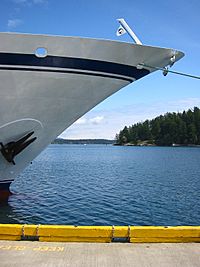Bow (ship) facts for kids

The bow is the very front part of a ship or boat. Think of it as the nose of the vessel. It's the part that leads the way when the ship is moving through the water.
The main job of the bow is to help the ship move smoothly. It's shaped to cut through the water easily, which reduces how much the water pushes back against the ship. This special shape also helps stop waves from washing over the front of the boat.
Contents
Why the Bow is Important
The bow is super important for a ship's journey. Its design helps the ship save fuel by reducing drag. Drag is the force that slows a ship down as it moves through water. A well-designed bow makes the ship more stable and comfortable for people on board, especially in rough seas.
Cutting Through Water
The shape of the bow helps the ship glide through the water. Instead of pushing a lot of water, it parts the water. This makes the ship more efficient. It uses less power to move forward.
Staying Dry
Another key role of the bow is to keep water out of the ship. It needs to be tall enough to rise above the waves. This stops water from splashing onto the deck. A good bow design helps keep the crew and cargo safe and dry.
Different Kinds of Bows
Ships and boats have many different bow shapes. Each shape is designed for a specific purpose. Some bows are made for speed, while others are for carrying heavy loads.
Bulbous Bow
A bulbous bow looks like a large, rounded bulb sticking out from the front of the ship, just below the waterline. This type of bow is common on large ships like container ships and oil tankers. It helps to create a special wave that cancels out some of the ship's own waves. This reduces drag and saves a lot of fuel.
Raked Bow
A raked bow slopes backward from the waterline. It's a very common and traditional bow shape. Many smaller boats and older ships have raked bows. They are simple and effective for many types of vessels.
Plumb Bow
A plumb bow goes straight down into the water. It doesn't slope forward or backward much. This design helps to make the ship's waterline longer. A longer waterline can sometimes mean a faster ship. Modern ships, especially yachts, sometimes use this design.
Inverted Bow
An inverted bow slopes forward from the waterline. It looks a bit like the bow is upside down. This design can help a ship cut through waves rather than ride over them. It's sometimes used on military ships or special research vessels.
Parts of the Bow
The bow isn't just one solid piece. It has several important parts that work together.
The Stem
The stem is the main structural part that forms the very front edge of the bow. It's like the backbone of the bow. The stem helps the bow withstand the forces of the water.
Forepeak
Inside the bow, there's often a space called the forepeak. This area is usually used for storage. It might hold things like anchor chains or other equipment.
Anchor Hawse
The anchor hawse is the opening in the bow where the anchor chain passes through. It's designed to let the anchor be lowered and raised smoothly.
Images for kids
-
The prow of USS Salem
See also
 In Spanish: Proa para niños
In Spanish: Proa para niños





